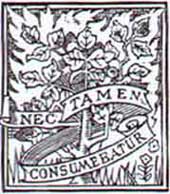I have just deleted a commentary on the multiple changes in the site today. I have been trying to balance readabilty with navigability. The last theme kept on sticking a post in a second column, or added ugly heads…
So I moved to Aesthetica. And that allowed me to again use a logo. So I found this one.
According to the Presbyterian Archives this was
The rather ornate symbol on the cover of the New Zealand Presbyterian Church News (Northern Church) published from 1872 until 1882, does not appear to have been picked up by any General Assembly Committee.
The text is Latin… Nec tamen consumbatur, from Exodus 3:2
2. And the Angel of the Lord appeared unto him in a flame of fire out of the midst of a bush; and he looked, and, behold, the bush burned with fire, and the bush was not consumed.
2. Et visus est ei Angelus Jehovae in flamma ignis e medio rubi: et vidit, et ecce rubus ardebat in igne, et rubus ipse non consumebatur.
The symbol of the burning bush, but not burned down, has fueled the imagination of the reformed. Consider for a second Calvin’s commentary — from whence I got the latin text — says.
But let us inquire who this Angel was? since soon afterwards he not only calls himself Jehovah, but claims the glory of the eternal and only God. Now, although this is an allowable manner of speaking, because the angels transfer to themselves the person and titles of God, when they are performing the commissions entrusted to them by him; and although it is plain from many passages, and [37] especially from the first chapter of Zechariah, that there is one head and chief of the angels who commands the others, the ancient teachers of the Church have rightly understood that the Eternal Son of God is so called in respect to his office as Mediator, which he figuratively bore from the beginning, although he really took it upon him only at his Incarnation. And Paul sufficiently expounds this mystery to us, when he plainly asserts that Christ was the leader of his people in the Desert. (1 Corinthians 10:4.) Therefore, although at that time, properly speaking, he was not yet the messenger of his Father, still his predestinated appointment to the office even then had this effect, that he manifested himself to the patriarchs, and was known in this character. Nor, indeed, had the saints ever any communication with God except through the promised Mediator. It is not then to be wondered at, if the Eternal Word of God, of one Godhead and essence with the Father, assumed the name of “the Angel” on the ground of his future mission. There is a great variety of opinions as to the vision. It is too forced an allegory to make, as some do, the body of Christ of the bush, because his heavenly majesty consumed it not when he chose to inhabit it. It is also improperly wrested by those who refer it to the stubborn spirit of the nation, because the Israelites were like thorns, which yield not to the flames. But when the natural sense is set forth, it will not be necessary to refute those which are improbable. This vision is very similar to that former one which Abraham saw. (Genesis 15:17.) He saw a burning lamp in the midst of a smoking furnace; and the reason assigned is, that God will not permit his people to be extinguished in darkness. The same similitude answers to the bush retaining its entireness in the midst of the flame. The bush is likened to the humble and despised people; their tyrannical oppression is not unlike the fire which would have consumed them, had not God miraculously interposed. Thus, by the presence of God, the bush escaped safely from the fire; as it is said in Psalm 46:1, that though the waves of trouble beat against the Church and threaten her destruction, yet “shall she not be moved,” for “God is in the midst of her.” Thus was the cruelly afflicted people aptly represented, who, though surrounded by flames, and feeling their heat, yet remained unconsumed, because they were guarded by the present help of God.
I have changed the favicon to version of this… and my gravatar.



Pingback: Lightning and the pedestal